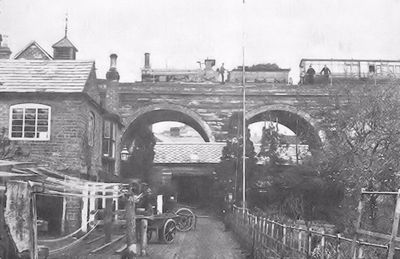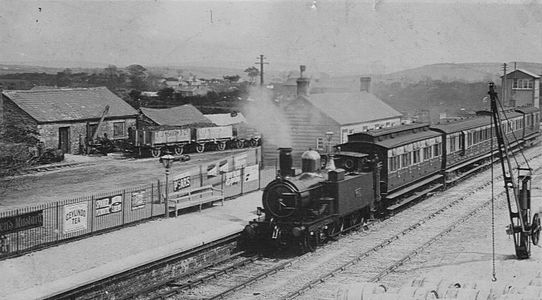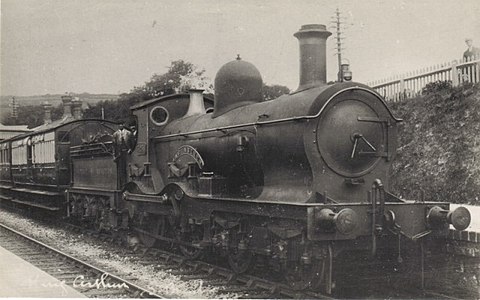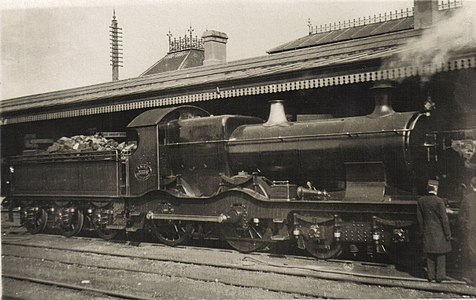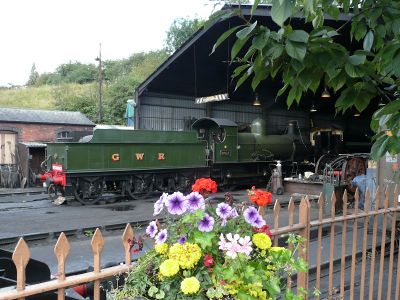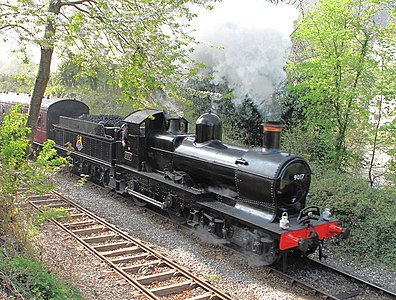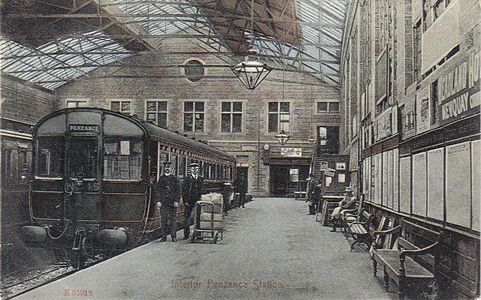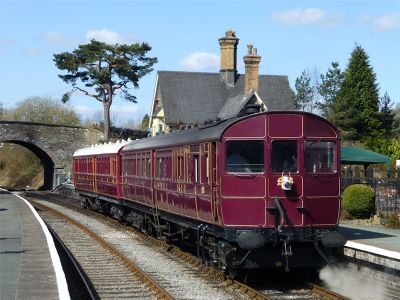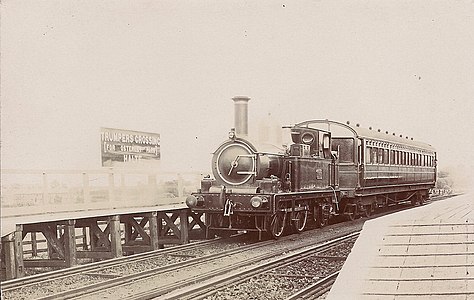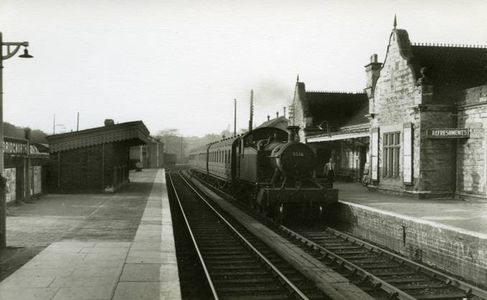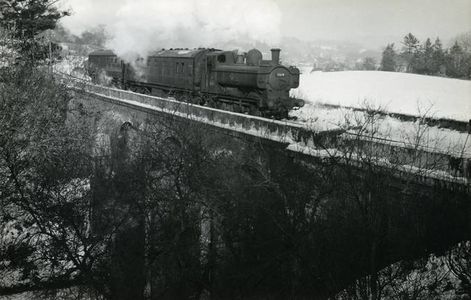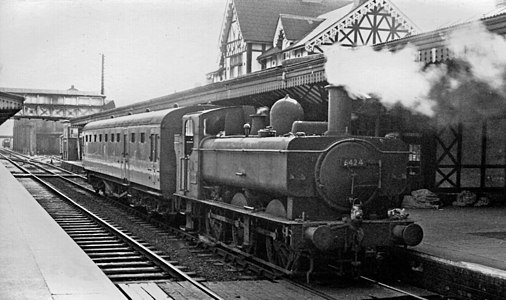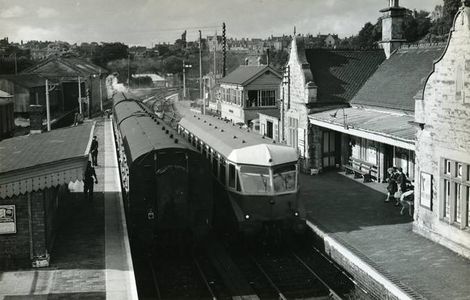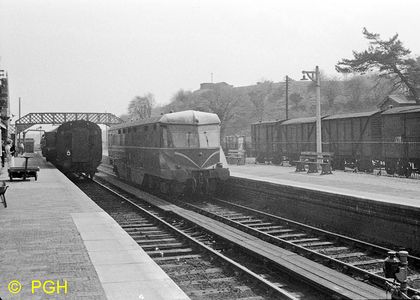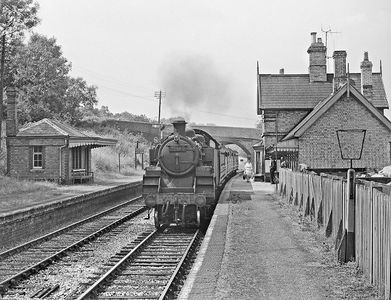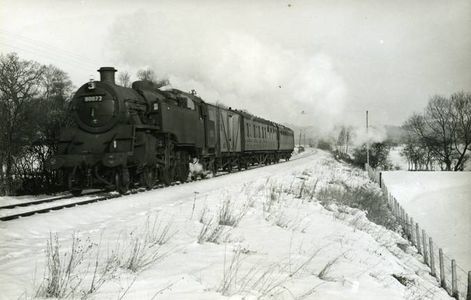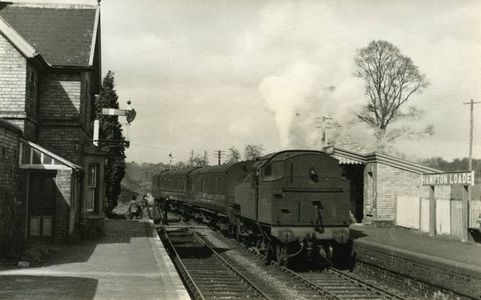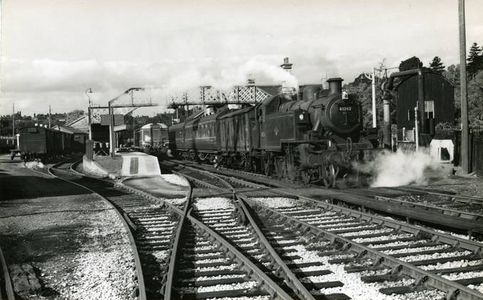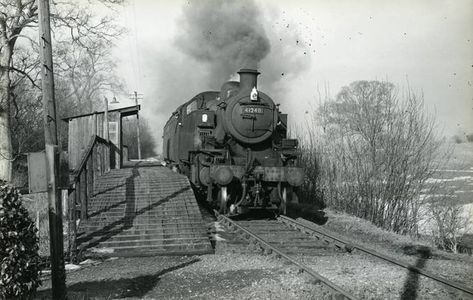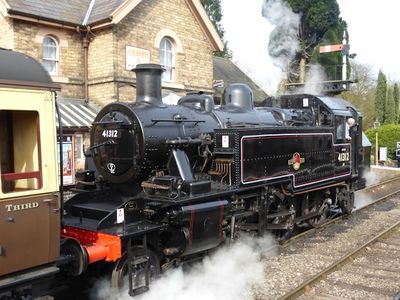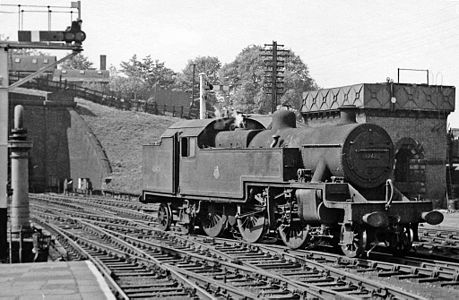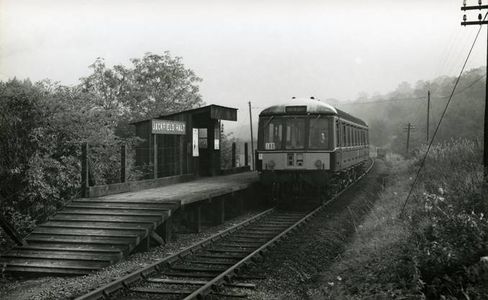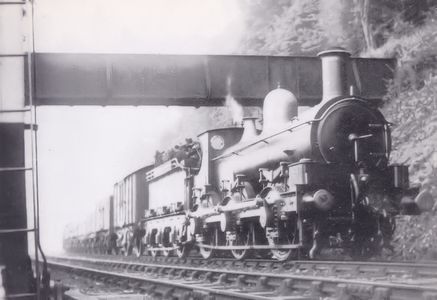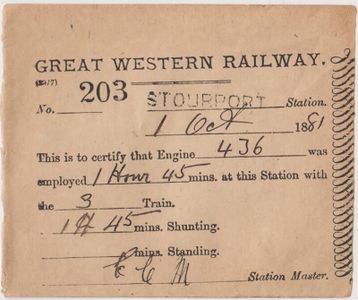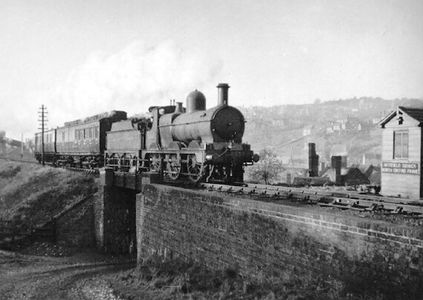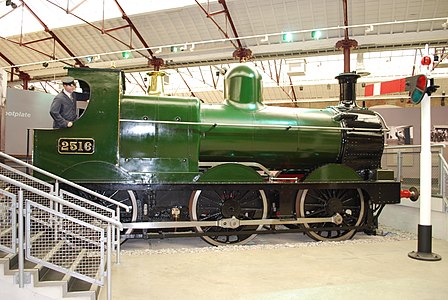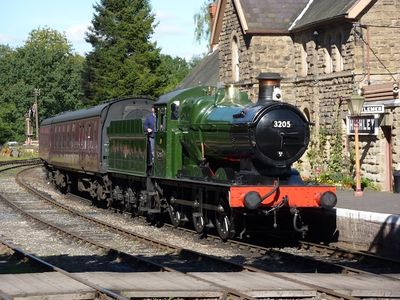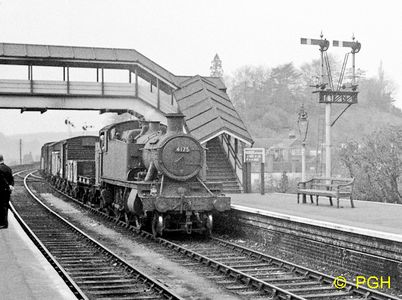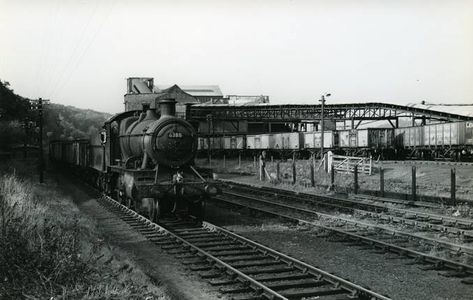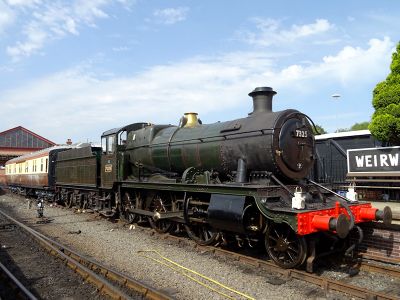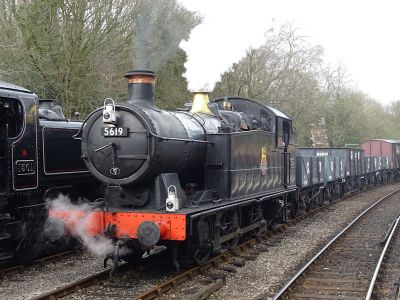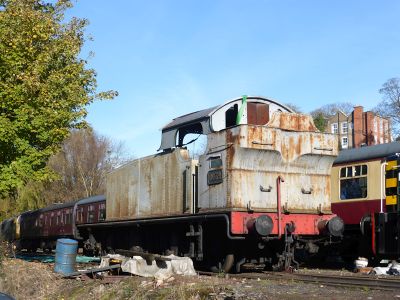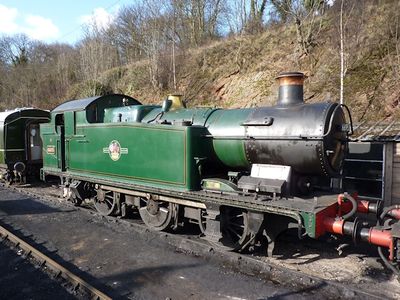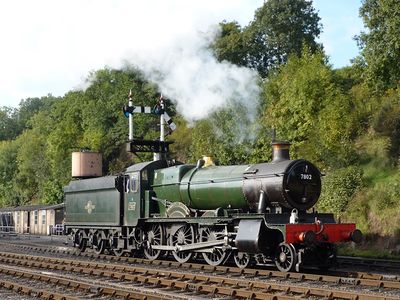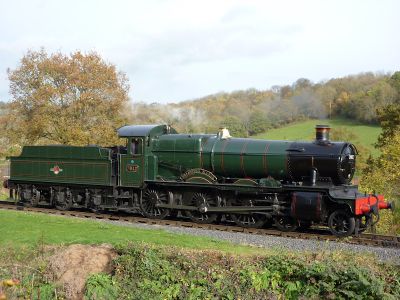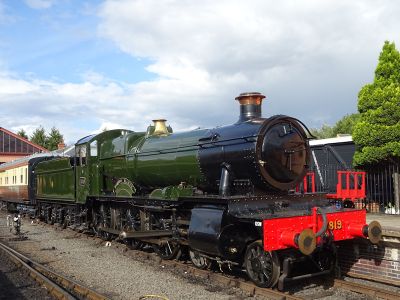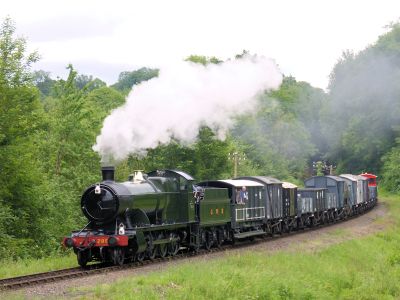Locomotives used on the Severn Valley Branch in commercial service
This page gives details and examples of the types of locomotives used on the Severn Valley Branch in commercial service from opening in 1862 until closure. For information on locomotives used since preservation see the rolling stock pages.
The article is intended to cover locomotives used regularly on scheduled passenger and freight services, including non-GWR locomotives used by the GWR during World War Two for passenger and freight services and ex-LMS locomotives used by BR. However it does not include the following:
- LNWR or LMS locomotives which ran over the Tenbury Branch and Kidderminster Loop Line via Bewdley under running rights before the BR era
- Cleobury Mortimer and Ditton Priors Light Railway locomotives working to that branch from Kidderminster Shed
- Locomotives used on wartime services such as Stourport hospital trains
- Locomotives visiting Bewdley and Stourport on Bank Holiday excursions.
- Locomotives involved in the construction of Ironbridge power station, or modern locomotives used to transport coal there via Coalbrookdale.
Due to the number involved, external links to Wikipedia pages giving more information on locomotive designers and locomotive classes are included within the article text rather than as a footnote. These may be identified by an external link icon thus: GWR 2201 Class.
Contents
Passenger and mixed traffic locomotives
The Severn Valley Branch opened in 1862 and was initially operated by the West Midland Railway whose locomotive superintendent was Edward Wilson. The WMR itself had been formed in 1860 by the amalgamation of a number of companies including the Oxford Worcester and Wolverhampton Railway. Locomotives of the WMR and its constituents were therefore the first to be used on the Severn Valley Branch.
Wilson remained in charge until the WMR was absorbed by the GWR in 1863. In 1864 Joseph Armstrong succeeded Sir Daniel Gooch as locomotive superintendent of the GWR at Swindon, while Joseph's brother George Armstrong ran the GWR's other works at Stafford Road, Wolverhampton. For some years thereafter, Swindon remained more involved in broad gauge locomotive design and construction while Wolverhampton was focused on standard gauge activities. Many of the constituent company locomotives were rebuilt there during their working lives, and a variety of 'Wolverhampton types' could be seen on the Severn Valley line until the end of the nineteenth century.[1]
- West Midland Railway and other locomotives inherited by the GWR: 2-4-0 locomotives were commonly used for passenger traffic during the 19th century, some continuing into the years leading up to World War 1. These included the following constituent company locomotives acquired by the GWR:
- Nos 106 and 107: 2-4-0 locomotives built by Fairburn in 1845, ex-Birkenhead Railway. Partly rebuilt at Wolverhampton in the 1870s. Withdrawn in 1900 and 1902.[2]
- No 151: 2-4-0 locomotive used until the 1920s.[3]
- No 180: 2-4-0 locomotive ex-OWW built by R&W Hawthorn in 1853, withdrawn 1899.[4]
- No 189: 2-4-0 locomotive ex OWW built by E.B. Wilson in 1855. This locomotive was involved in the derailment at Bridgnorth in 1867. Withdrawn in 1886.[3]
- Nos 190-193, double-framed 2-4-0s, WMR Nos 93-6 ex Newport, Abergavenny and Hereford Railway, built by E.B. Wilson & Co in 1855-6. Rebuilt twice at Wolverhampton, withdrawn between 1899 and 1903.
- GWR 439 Class: these inside frame 2-4-0s were some of the first GWR-built locomotives on the Branch. Originally designed by Joseph Armstrong and built at Swindon in 1868, they were nicknamed 'Bicycles' because of their unusual appearance. Those that served on the Branch were later re-built under George Armstrong at Wolverhampton in 1885-6.
- GWR 455 Class 2-4-0T 'Metro Tank': The 455 Class 'Metro Tank' was another Joseph Armstrong design, built at Swindon between 1869 and 1899 with the later examples built under William Dean who succeeded Armstrong in 1877. They were an exception to the general use of 2-4-0s on the Branch at the time. The two Armstrong brothers were independent characters; while Joseph preferred the 2-4-0T layout over the 0-4-2T, his brother George built no 2-4-0T locomotives at Wolverhampton.
- GWR 2201 Class: Dean's inside-framed 2-4-0s worked many passenger trains on the branch. They were built at Swindon in 1881-2 and were a domeless-boilered development of Joseph Armstrong's 806 class. No 2209 was photographed on a Shrewsbury to Kidderminster service on 11 June 1915.[5] All the class had been withdrawn by the end of 1921.
- Barnums: A number of 'Barnums' were used on the Branch.[2][1] The true 'Barnums' were the GWR 3206 Class, built in 1889 and considered William Dean's most successful 2-4-0 design. They were the last GWR locos built with "sandwich" frames. They began life as express mixed traffic locomotives but by the 1920s had been relegated to work on branch lines such as the Severn Valley.[6] Nabarro suggests the term was applied to other earlier classes of 2-4-0 including the Joseph Armstrong GWR 717 class single framed 2-4-0, the 439 class (see above), and the Gooch GWR 149 class[1].
- GWR 3252 'Duke' Class: 'Dukes' were outside framed 4-4-0 locomotives built under Dean between 1895 and 1899 and originally intended for express passenger train work. However several worked on the Severn Valley Branch as late as World War II, including 3254 Cornubia (shedded at Kidderminster), 3284 Isle of Jersey (shedded at Stourbridge) and 3276 (formerly called 'Dartmoor', shedded at Shrewsbury)[1].
- GWR 3300 Class: Dean's double-framed inside cylinder 4-4-0 'Bulldogs' (built 1898-1910) also appeared on the Branch during the Second World War. No. 3393 Australia was Kidderminster Shed's only 'named locomotive', being allocated there between January and July 1946, from where it mainly worked goods trains to Shrewsbury[7].
- GWR 3200 Class: A number of Dean's 'Bulldogs' were subsequently rebuilt under Charles (C.B.) Collett with 'Duke' boilers in the in the late 1930s to become the 'Earl Class', commonly referred to as 'Dukedogs'. Dukedogs also appeared in occasional use on the Branch in the 1940s and early 50s. One example is preserved, No. 9017 Earl of Berkeley, which visited the SVR for the 2008 Autumn Steam Gala.
- GWR Steam Railmotor: Dean was succeeded as Locomotive, Carriage and Wagon Superintendent by George Jackson Churchward in 1902. Churchward served as such until 1921 (the role was renamed Chief Mechanical Engineer or "CME" in 1916. Churchward designed Steam Railmotors were introduced in 1905, mainly working local services at the southern end of the line. Their use continued until the beginning of the 1920s, when they were replaced by auto coaches (also known as auto cars or auto trailers). They were all subsequently converted to unpowered auto coaches although Railmotor 93 has been restored at Didcot.
- GWR 517 Class: Auto coach workings initially used Dean's 517 Class 0-4-2T. They worked local services at the southern end of the line and occasionally as far as Bridgnorth.
- GWR 4500 Class: In late 1927 new Churchward 4500 Class small prairies were allocated to Kidderminster Shed from where they entered service on the Branch. Within months one, No. 5508, was involved in an accident when becoming derailed north of Bridgnorth Tunnel after rotten sleepers gave way. Despite this unfortunate beginning these 2-6-2 tanks quickly proved popular with crews and became the main source of motive power until the 1950s for both passenger and freight workings, supplemented by use of pannier tanks. The SVR's 4566 is one of a number of preserved examples. Class members of variant GWR 4575 Class also saw service.
Ex-GWR Small Prairie 5538 with a passenger train (Sellick Collection)
- GWR 5700 Class: Churchward was succeeded as CME in 1921 by Collett. He designed the most prolific class of GWR locomotive, the 0-6-0PT 'pannier tank' of which more than 860 were built between 1929 and 1950. Although nominally intended for shunting duties (which they carried out at Kidderminster Goods Yard and elsewhere), they were regularly used on local freight and passenger workings in which capacity they served on the Branch until closure. Fittingly, on Sunday 8 September the final 6.58pm Bridgnorth to Birmingham Snow Hill train, normally a diesel railcar service, was hauled by ex-GWR pannier tanks 9624 and 4665 carrying a ‘Special Last Train’ headboard. Many examples are preserved including the SVR's 5764 and 7714.
Ex-GWR Pannier 3619 on a Southbound passenger train in 1963 (Sellick Collection)
- GWR 6400 Class: A further Collett design, for light passenger and push pull workings, and classified by BR as 2P. Three survived to preservation and 6412, 6430 and 6435 have all visited the SVR for galas.
- GWR AEC Diesel Railcar: Another of Collett's designs, GWR Diesel Railcars were introduced in 1936 on passenger services between Kidderminster, Hartlebury and Stourport, and after World War 2 they were occasionally used on services travelling the whole length of the line. They were generally a successful design although several examples caught fire including No. 10 which was burnt out at Bridgnorth in March 1956. Four examples are preserved including Railcar 22 which was resident on the SVR for some years.
An ex-GWR Diesel Railcar passes a steam-hauled passenger service (Sellick Collection)
- GWR 5101 Class 'Large Prairie: First used during the Second World War. Covered under goods locomotives below, although they also saw regular use on passenger services.
- BR Standard 3MT 2-6-2T: Following nationalisation in 1947, the line at first continued to use predominantly ex-GWR locomotives. From their introduction in 1952/3 BR Standard 3 tanks appeared on the Severn Valley line.[8] In October 1955 the GWR prairies allocated to Shrewsbury were transferred to South Wales and replaced initially by 3 BR Standard 3MT 2-6-2T's together with various ex-LMS tank engines (see below)[9]. 45 BR Standard 3MT 2-6-2T locomotives were built at BR's Swindon works between 1952 and 1955. 13 were allocated at various times to Shrewsbury and two to Kidderminster Shed, with only one locomotive (82030) featuring on both lists.[10] At least eight of the class were photographed in service on the Severn Valley Branch while allocated to Shrewsbury:
| Number | Loco shed allocation | Published photographs |
|---|---|---|
| 82000 | Shrewsbury 1955-1959 | Bewdley 1960[11] |
| 82004 | Shrewsbury Jun-Sep 1959 | Bridgnorth 1959[12], Eardington 1959[13] |
| 82005 | Shrewsbury Apr-Jul 1961 | Stourport 1961[14] |
| 82007 | Shrewsbury Dec 1955-Jun 1958 | Bewdley 1956[15] |
| 82009 | Shrewsbury Jun-Sep 1959 | Coalport 1959[16] |
| 82021 | Shrewsbury Jan-Mar 1960 | Bewdley 1960[17] |
| 82031 | Shrewsbury 1955-1959 | Bewdley 1957[18] |
| 82032 | Shrewsbury Apr-Aug 1961, Dec 1961-Jul 1964 | Kidderminster 1961[19] |
A further 18 of the class were to have been built, but the order for these was cancelled as part of BR’s Modernisation Plan. The closure of branch lines such as the Severn Valley and the replacement of steam by DMU services ultimately led to the withdrawal from service of those already built. None survive, although new build BR 3MT 82045 is under construction at Bridgnorth.
BR 3MT 82009 at Coalport in 1959
- BR Standard 4MT 2-6-4T class: The SVR's 80079 is an example of the larger Class 4 tank. Several Class 4 tanks were allocated to Shrewsbury 89A from mid-1962 onwards from where they worked services towards the Cambrian Coast, which included a few displaced from the London, Tilbury and Southend line by electrification.[20]
| Locomotive | Dates | Notes |
|---|---|---|
| 80078 | July 1962 to February 1963 | Locomotive preserved |
| 80096 | July 1962 to November 1962 | |
| 80100 | July 1962 to July 1965 | Locomotive preserved |
| 80101 | July 1962 to September 1962 | |
| 80135 | July 1962 to February 1963 | Locomotive preserved |
| 80136 | July 1962 to February 1963 | Locomotive preserved and has visited the SVR in preservation |
| 80098 | September 1962 to November 1962 | Locomotive preserved and has visited the SVR in preservation |
| 80105 | September 1962 to October 1962 | Locomotive preserved |
| 80131 | September 1962 to February 1963 | |
| 80070 | December 1962 to February 1963 | |
| 80102 | December 1962 to June 1964 | |
| 80132 | December 1962 to February 1963 | |
| 80070 | March 1963 to May 1965 |
They remained until the end of passenger working, especially north of Bridgnorth.[2][21] It appears they featured much less regularly than the BR Standard 3MT 82000 tanks and LMR Ivatt 2MT 41000 tanks also in use from Shrewsbury at that time.
There is little photographic evidence of their use on the Severn Valley, with the following identified:
- 80070 on the daily Shrewsbury to Kidderminster pick-up freight at Northwood on 29 May 1963.[22]
- 80072 was photographed on the line on three occasions during the very cold winter of 1962-63 (whilst allocated to Swansea East Dock, 87D). This locomotive is preserved and has visited the SVR in preservation.
- 80078 at Bridgnorth in 1963 working from Shrewsbury[23]
- John Stretton captions an image of 80079 emerging from Bridgnorth Tunnel on 30 August 1962 on the 7.27p.m. Bridgnorth to Shrewsbury, a rarity of a now SVR-based loco that ran on the branch in service.[24]
- Swansea-based 80099 in charge of a northbound two carriage passenger service at Bridgnorth on 28 July 1962.[25]
- 80100 in circa 1962 at Buildwas[26]
- 80102 on the last day of service in September 1963[21].
Their use on the branch possibly included deputising for failed locomotives as their 'Blue' route availability would theoretically have restricted their speed to 25mph, with the Severn Valley branch classified as ‘dotted blue’ from Bewdley to Buildwas[27].
BR 4MT 80072 with a Southbound passenger (Sellick Collection)
- LMS Stanier 3P 2-6-2T: A pre-War design, four members of this class (40086, 40110, 40126 and 40205) were allocated to Shrewsbury and a single example (40085) to Kidderminster, all during periods between February 1960 and November 1962.[28] No. 40110 was photographed at Bridgnorth in 1961.[29] No members of the class survive in preservation.
LMS Stanier 3P 2-6-2T 40126 at Hampton Loade on 14 April 1962 (Sellick Collection)
- LMS Ivatt Class 2 2-6-2T: Members of this post-War class used on the Branch in 1962-3 included Nos. 41202, 41203, 41207, 41209, 41240 and 41304. 41207 worked the last ever Bridgnorth to Shrewsbury passenger service on 7 September 1963.[2] Four members of the class are preserved, of which two (41241 and 41312) have visited the SVR for Gala events.
Ex-LMS Ivatt 2MT 41202 and a BR DMU (Sellick Collection)
Ex-LMS Ivatt 2MT 41240 at Cound Halt (Sellick Collection)
- LMS Fowler 4MT 2-6-4T: 125 of these passenger tanks were built by the LMS between 1927 and 1934. Rated as 4P by the LMS and later as 4MT under BR, they were the first of the family of LMS/BR Class 4 2-6-4T locomotives which culminated in the BR Standard 4MT 2-6-4T (see above). Six members of the class (42320/62/72/95/418/20) were allocated to Shrewsbury for a few months in 1959.[30] No members of the class survive in preservation. No 42420 was photographed at Bridgnorth in May 1959.[9]
- BR DMUs: During the last years of the Branch, the GWR diesel railcars were replaced by first generation BR DMUs. The DMUs used on the line included the Class 116 built by BR Derby from 1957 to 1961, an unidentified example being photographed at Arley in 1961 by James S Doubleday. Also used was the Class 122 'Bubble car' built by GCRW in 1958. Class 122 W55018 was photographed at Jackfield in 1963[3].
A DMU service at Jackfield Halt in 1962. (Sellick Collection)
Goods locomotives
- "Beyer"_Class GWR 322 Class 'Beyer': The 322 Class 'Beyer', or sometimes 'Beyer Goods', was a Daniel Gooch design 0-6-0 built by Beyer, Peacock & Co. of Manchester between 1864 and 1866, the final 10 ordered by Joseph Armstrong being the last 19th-century GWR locomotives built for the GWR by an outside contractor. No 344 was pictured approaching Bewdley circa 1900 (right), while another Beyer, No 322, was pictured shunting at Bewdley as late as circa 1925.[1]
- GWR 388 class 'Standard Goods': Joseph Armstrong's 388 Class 'Standard Goods' was a double-framed 0-6-0 with 5ft driving wheels, built at Swindon between 1866 and 1876. A number worked on the Branch, including one photographed on a northbound freight at Arley circa 1908.[5]
- GWR 927 class 'Coal Goods': Armstrong's 'Coal Engine' or 'Coal Goods' was essentially a variant of his Standard Goods with smaller 4ft 6in driving wheels, built at Swindon in 1874. These also worked on the Branch, including No 946 which was photographed on a Kidderminster-Shrewsbury mixed goods on 11 June 1915.[5] No examples of Armstrong locomotives have survived into preservation.
- 2301 class 'Dean Goods': Joseph Armstrong's successor William Dean developed the 0-6-0 'Dean Goods', 260 of which were built at Swindon between 1883 and 1899. 'Dean Goods' could be seen on the Branch for around sixty years with the last examples of the class not being withdrawn by BR until 1957. One example, no. 2516 is preserved as a static exhibit at Swindon's 'Steam' Museum.
A GWR Dean Goods approaching Jackfield sidings.
- GWR 2251 Class: Collett's 2251 Class 0-6-0 was introduced in 1930 as a replacement for the 'Dean Goods'. The 2251 class was intended for medium-powered freight duties with 120 being built by 1948. A number of the class including 3205 were used on the Severn Valley Branch from the mid-1950s onward, mostly operating from Shrewsbury although No. 2207 was housed at Kidderminster Shed from where it regularly worked the daily 'Salop Goods'.[31] As well as freight duties, they worked occasional summer Sunday passenger trains[2][1]. 3205, the only surviving member of the class, was the first locomotive to arrive on the SVR in preservation, remaining resident for the next 20 years.
- GWR 2600 'Aberdare' Class: A class of Dean 2-6-0 freight locomotives built between 1900 and 1907 and intended for hauling coal trains between Aberdare and Swindon. A number survived into the Second World War and were allocated to various local sheds. 2608, 2620 and 2655 from Stourbridge and 2680 from Hereford regularly worked the wartime 'Tenbury goods'.[32]
- LNER Class J25: During the Second World War, 40 LNER J25 Class 0-6-0 locomotives (originally Worsdell NER Class P1 and dating from around the turn of the century) were loaned to the GWR. Initially three were allocated to Shrewsbury (257,536, 2059) from where they worked goods trains to Kidderminster and Hartlebury. Worcester received 10 (1986, 2040, 2051, 2058, 2061, 2065, 2075, 2138, 2141, 2142), many of which also worked on the Branch. Others at Stourbridge (29, 1973, 2000, 2126) and Hereford (1994, 2053, 2072) worked the Hereford-Tenbury-Stourbridge goods services. Two Stourbridge and three Worcester locomotives were returned to the LNER in 1943, while most of the other Worcester locomotives were transferred to Kidderminster Shed in 1944,[33] from where they continued to work goods services on the Branch, with one photographed at Arley in 1945.[5][note 1] The last example was withdrawn in 1963 and none survived into preservation.[34]
- GWR 5101 Class 'Large Prairie': During World War 2 Collett's 51xx large prairies were first introduced on the Branch, after which they saw regular use on colliery and other freight workings as well as passenger services. A number of examples are preserved including the SVR's 5164 and 4150.
- GWR 4300 Class: Although designated a mixed traffic locomotive, Churchward's GWR 4300 class 2-6-0 (built 1911–1932) was commonly seen on freight duties post-World War 2. Examples photographed include Nos 6314,[1] 6382[5], 6393[35], 5333[3] and 5355[36]. They also operated passenger turns such as 6314 operating a Kidderminster to Shrewsbury service on 19 May 1959. The SVR's 7325 is one of the final batch of 20 including design changes by Collett, and one of only two preserved examples of the class.
Ex-GWR 43xx 2-6-0 6388 with a coal train at Alveley Sidings (Sellick Collection)
- GWR 5600 Class: The 200-strong Collett 5600 class 0-6-2T was introduced in 1924 as a mass replacement of pre-grouping locomotives in South Wales coal traffic. Three examples were shedded at Kidderminster.[37] Being classified 'Red', they were too heavy to work between Bewdley and Buildwas although on one occasion one was sent to Alveley by mistake. No. 6679 was used regularly from 1957 until the end of steam on trains for hauling coal trains ('Slack trips') from Hartlebury to Stourport Power Station.[38][39] In preservation 6634 is a former resident (though it left the SVR unrestored); 5619, 5643 and 6695 have all had periods on hire to the SVR; and 5637 and 6619 have visited the SVR for galas.
- GWR 7800 'Manor' Class: Collett's GWR 7800 Manor class 4-6-0s, introduced in 1938, were occasionally seen on troop trains during the Second World War.[40] Although the 4300 Class was the most commonly used tender locomotive for goods working on the Branch post-War, Manors were also used for mixed freight working from time to time.[1] The Manor was designed as a lighter weight mixed traffic locomotive with better route availability (Blue) than the heavier Halls and Granges (Red). As most of the Branch was classified 'dotted blue', 'Red' locomotives were prohibited but 'Blue' locomotives were permitted subject to speed restrictions, making them suitable for slower freight trains. There is photographic evidence of Wyre Forest Line trains via the Severn Valley Branch, such as ex-GWR 4 6-0 No. 7810 'Draycott Manor' crossing Dowles Bridge with a goods train in 1955.[41] The SVR is home to three preserved examples, 7802 Bradley Manor, 7812 Erlestoke Manor and 7819 Hinton Manor.
- GWR 2800 Class: The Post-War 'dotted blue' classification applied to the portion of the Branch between Bewdley and Buildwas, where the Collieries served by the Severn Valley Railway were situated, began "Engines in the "Blue" group (with the exception of the 2-8-0 types)...". Churchward's 2800 Class 2-8-0 freight locomotives, although rated 'blue', were thus too heavy to work over that portion of the Branch. However they were used at the north end of the Branch as far south as Ironbridge power station at Buildwas, as were similarly sized ex-ROD 2-8-0s. The 2800 class is also known to have worked between Hartlebury and Stourport to serve the Stourport Power Station as late as 1965.[2] A number of the 2800 class are preserved including the SVR's 2857.
2857 on a Demonstration Goods Train (2018)
- BR Standard Class 9F: In the final years of the Branch, heavy coal trains to the Ironbridge and Stourport power stations were occasional worked by a BR Standard 9F.[1]. Two 9Fs, 92212 and 92214, have spent periods on hire to the SVR in preservation.
- LMS Standard Class 8F: Ex-LMS Stanier 8Fs similar to the SVR's 48773 were also used on occasion in the last years of the Branch. Classmate 48531, then based at Wolverhampton's Oxley MPD, was photographed working a southbound coal train at Bewdley on 3 and 29 June 1966[42][43].
Diesels
- Alveley Colliery workings continued until closure in 1969. However steam haulage at the southern end of the line ended with the closure of Stourbridge shed in 1966. After that time BR Diesels were used, mainly the Sulzer Type 2 (BR Class 25) and occasionally the E.E. Type 1 (BR Class 20). Examples of both types have been formerly resident on the SVR in preservation.
- Steam remained diagrammed on Buildwas coal trains as late as Easter 1967 before also being replaced by diesels.[2] Images show BR Class 56, 58 and 66 used. Charter passenger trains also used BR Class 20 and 37[44].
- British Sugar Corporation factory at Foley Park, Kidderminster. This utilised Ruston and Hornsby 165hp diesel shunters with incoming beet trains usually tripped from Kidderminster by a Class 08 shunter.
- Until 1988, a stub of the Severn Valley line remained in use from Sutton Bridge Junction Signal Box, providing via a reverse move access to the site of Shrewsbury Abbey station (Shropshire & Montgomeryshire Light Railway), which remained in use as a fuel terminal with incoming oil trains usually tripped by a Class 08 shunter.
- The section of the SV branch between Berrington and Shrewsbury continued in use for testing Sentinel diesels until finally being closed by BR on 21 January 1968.[45] It featured several types of Sentinel locomotives.
Notes
- ↑ Asleft (1978) refers to use of an LNER J21 (ex NER C1) on the Branch. This may refer to the J25s.
See also
References
- ↑ 1.0 1.1 1.2 1.3 1.4 1.5 1.6 1.7 1.8 Nabarro (1971), pp 57-63, 'Locomotives on the Line, 1862-1968', plus various photos
- ↑ 2.0 2.1 2.2 2.3 2.4 2.5 2.6 Smith (1968)
- ↑ 3.0 3.1 3.2 3.3 Vanns (1998) pp. 14-21, 'Locomotives'.
- ↑ Marshall (1989) pp. 135-138, 'Signalling and Operations: Locomotives', plus various photos.
- ↑ 5.0 5.1 5.2 5.3 5.4 Geens (1985)
- ↑ Wikipedia
- ↑ Turley (2005) p. 126.
- ↑ November news, 82045 SLT
- ↑ 9.0 9.1 Webb (2006) p. 36.
- ↑ BR Database
- ↑ Nabarro (1971) p. 28.
- ↑ Mitchell & Smith (2007) p. 69.
- ↑ The 82045 Steam Locomotive Trust, October 2020 news (Retrieved 30 October 2020)
- ↑ Mitchell & Smith (2007) p. 7.
- ↑ Webb p. 20.
- ↑ Peter Shoesmith Collection, see infobox
- ↑ Smith (1968) p. 18.
- ↑ SVR News 146 p. 64.
- ↑ SVR News 52 p. 11.
- ↑ 80000 page, BRDatabase (Retrieved 23 April 2017)
- ↑ 21.0 21.1 Magner (1997)
- ↑ Bewdley Station waiting room
- ↑ SVR News No. 15
- ↑ Stretton (2010) p. 90
- ↑ David Adams' image on Facebook (Retrieved 22 November 2021)
- ↑ Railonline.co.uk
- ↑ ‘Locomotive Route Availability’, Michael Clemens’ Railways (Retrieved 30 March 2017)
- ↑ LMS Stanier "3P" Class 2-6-2T page, BR Database (Retrieved 4 November 2020)
- ↑ Hale (1973) p. 24.
- ↑ LMS Fowler "4P" Class 2-6-4Tpage on BR database (Retrieved 5 November 2020)
- ↑ Barfield (1981) p. 52.
- ↑ Turley (2005) p. 67.
- ↑ Turley (2005) pp. 15,106.
- ↑ LNER Encyclopedia
- ↑ Vanns (2013)
- ↑ Mitchell and Smith (2007)
- ↑ Kidderminster Shed, BR Database(Retrieved 20 November 2020)
- ↑ Turley (2005) p. 70.
- ↑ Booth, A., 'CEGB, Stourport Power Station', Railways in Worcestershire (Retrieved 20 November 2020)
- ↑ Smith (1968) p. 24.
- ↑ Turley, Adrian, in Beddoes & Smith (1995)
- ↑ Siviter, Roger, image on 8F Society website (Retrieved 7 November 2022)
- ↑ Vanns (2017) p. 55.
- ↑ Geoff's Rail Diaries webpage (Retrieved 30 July 2022)
- ↑ Mitchell & Smith (2007) p. 35.
Links
- See above
